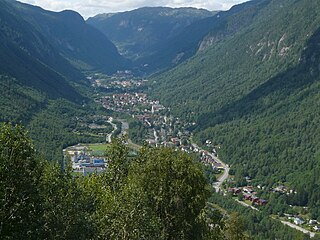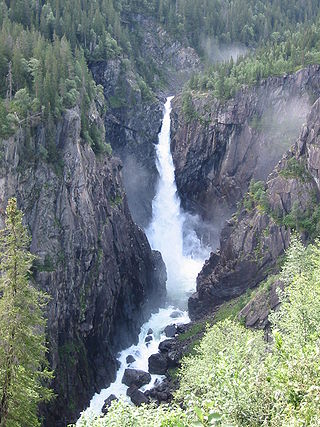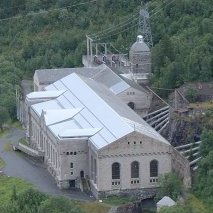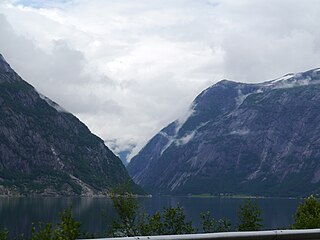
Tinn is a municipality in Telemark county, Norway. It is located in the traditional districts of Aust-Telemark and Upper Telemark. The administrative centre of the municipality is the town of Rjukan. Some of the villages in Tinn include Atrå, Austbygde, Hovin, and Miland.

Norsk Hydro ASA is a Norwegian aluminium and renewable energy company, headquartered in Oslo. It is one of the largest aluminium companies worldwide. It has operations in some 50 countries around the world and is active on all continents. The Norwegian state owns 34.3% of the company through the Ministry of Trade, Industry and Fisheries. A further 6.5% is owned by Folketrygdfond, which administers the Government Pension Fund of Norway. Norsk Hydro employs approximately 35,000 people. Eivind Kallevik has been the CEO since May, 2024, following Hilde Merete Aasheim.

Rjukan is a town in Tinn Municipality in Telemark county, Norway. The town is also the administrative centre of Tinn Municipality. The town is located in the Vestfjorddalen valley, between the lakes Møsvatn and Tinnsjå. The municipal council of Tinn declared town status for Rjukan in 1996. The town is located about 10 kilometres (6.2 mi) to the west of the village of Miland and about 20 kilometres (12 mi) to the northwest of the village of Tuddal.

The Norwegian heavy water sabotage was a series of Allied-led efforts to halt German heavy water production via hydroelectric plants in Nazi Germany-occupied Norway during World War II, involving both Norwegian commandos and Allied bombing raids. During the war, the Allies sought to inhibit the German development of nuclear weapons with the removal of heavy water and the destruction of heavy-water production plants. The Norwegian heavy water sabotage was aimed at the 60 MW Vemork power station at the Rjukan waterfall in Telemark.

Vemork is a hydroelectric power plant outside the town of Rjukan in Tinn Municipality in Telemark county, Norway. The plant was built by Norsk Hydro and opened in 1911, its main purpose being to fix nitrogen for the production of fertilizer. At opening, it was the world's largest power plant with a capacity of 108 megawatts (145,000 hp).

Samuel Eyde was a Norwegian engineer and industrialist. He was the founder of both Norsk Hydro and Elkem.

The Bratsberg Line is a 74-kilometre long (46 mi) railway line between Eidanger and Notodden in Telemark county, Norway. It opened in 1917, connecting the Tinnos Line, the Sørland Line and the Vestfold Line; allowing Norsk Hydro to transport fertilizer from their plant at Rjukan to the port in Skien. Since 1991 only passenger trains are operated, using Class 69 stock by Vy.

Rjukan Falls (English) or Rjukanfossen (Norwegian) is a waterfall in the western part of the Vestfjorddalen valley in Tinn Municipality in Telemark county, Norway. The 104-metre (341 ft) tall waterfall is located on the river Måna, about 5 kilometres (3.1 mi) to the west of the town of Rjukan.

Otto Aasen was a Norwegian Nordic skier.

The Rjukan Line, at first called the Vestfjorddal Line, was a 16-kilometre (10 mi) Norwegian railway line running through Vestfjorddalen between Mæl and Rjukan in Telemark county. The railway's main purpose was to transport chemicals from Norsk Hydro's plant at Rjukan to the port at Skien, in addition to passenger transport. At Mæl the wagons were shipped 30 kilometres (19 mi) on the Tinnsjø railway ferry to Tinnoset where they connected to the Tinnoset Line. The Rjukan Line and the ferries were operated by Norsk Transport, a subsidiary of Norsk Hydro.

The Tinnoset Line was a 30-kilometer (19 mi) long Norwegian railway line that went from Tinnoset to Notodden in Telemark county. The railway was part of the transport chain used to transport fertilizer from Norsk Hydro's factory in Rjukan to the port in Skien. The railway opened in 1909 and was closed when the plant closed in 1991. The railway is sometimes mistakenly believed to be part of the Rjukan Line.

Tinnsjø railway ferry was a Norwegian railway ferry service on Lake Tinn that connected the Rjukan Line and Tinnoset Line. The 30-kilometer (19 mi) long ferry trip made it possible for Norsk Hydro to transport its fertilizer from the plant at Rjukan to the port in Skien. The ferry services were operated by the company's subsidiary Norsk Transport from 1909 to 1991, when the plant closed.

SF Hydro was a Norwegian steam powered railway ferry that operated in the first half of the 20th century on Lake Tinn in Telemark. It connected with the Rjukan Line and Tinnoset Line, at Mæl and Tinnoset, operating between 1914 and 1944. The combined track and ferry service was primarily used to transport raw materials and fertilizer from Norsk Hydro's factory at Rjukan to the port in Skien. It was the target of a Norwegian operation on 20 February 1944, when resistance fighters sank the ferry in the deepest part of Lake Tinn to prevent Nazi Germany from receiving heavy water.

SF Ammonia is a steam-powered railway ferry on Lake Tinn in Telemark, Norway. The ferry was one of the four railway ferries on Lake Tinn that connected the Rjukan Line with the Tinnoset Line. This system was used by Norsk Hydro to transport chemicals from Rjukan to the port in Skien. The ferry is one of four remaining steam-powered railway ferries in the world, and can still be seen docked at Mæl, Norway.

Notodden New Station served Notodden, Norway from 1919 to 2004, and again from 2015 to 2020. The station was designed by Gudmund Hoel, finished in 1917 and taken into use two years later when the Bratsberg Line opened.

Norwegian Industrial Workers Museum is an industrial museum located at Rjukan in Tinn, Norway. Located in the Vemork power station, it was established in 1988 to allow the preservation of industrial society created by Norsk Hydro when they established themselves in Rjukan in 1907. The museum is an anchor point on the European Route of Industrial Heritage.

Norsk Hydro Rjukan is an industrial facility operated by Norsk Hydro at Rjukan in Tinn, Norway, from 1911 to 1991. The plant manufactured chemicals related to the production of fertilizer, initially potassium nitrate from arc-produced nitric acid and later ammonia, hydrogen, and heavy water. The location was chosen for its vicinity to hydroelectric power plants built in the Måna river.

Hydro Transport AS was a railway- and shipping company responsible for the transport of chemicals from Norsk Hydro Rjukan. A subsidiary of Norsk Hydro, the company was founded in 1907, operations ceased in 1991, while the company became defunct at the end of 2009.

The Norseman Xtreme Triathlon is a non-Ironman branded triathlon, point to point, race held in Norway annually. The distances are equivalent to those of an Ironman race with the swim starting from the loading bay of a car ferry, through the water of the Hardanger fjord to the local town, Eidfjord. At Eidfjord the competitors transition onto their bikes and then cycle 180 km through the mountains, the first 40 km of which is uphill. After transition two, the competitors then run 42.2 km of which the first 25 km are flat and following this they end up climbing the local mountain, Gaustatoppen, 1,880 m above sea level.

The Rjukan–Notodden Industrial Heritage Site is a World Heritage Site in Telemark county, Norway, created to protect the industrial landscape around Lake Heddalsvatnet and Vestfjorddalen valley. The landscape is centered on the plant built by the Norsk Hydro company to produce calcium nitrate fertilizer from atmospheric nitrogen using the Birkeland–Eyde process. The complex also includes hydroelectric power plants, railways, transmission lines, factories, and workers' accommodation and social institutions in the towns of Notodden and Rjukan.

















